介词表时间用法
初中英语介词用法总结与归纳
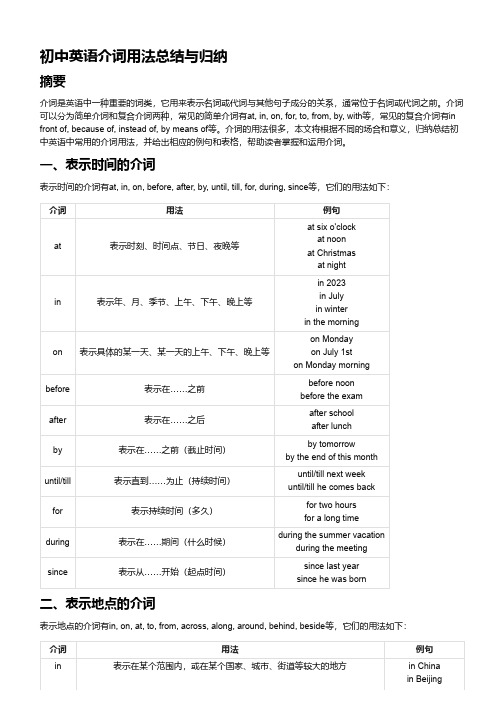
初中英语介词用法总结与归纳摘要介词是英语中一种重要的词类,它用来表示名词或代词与其他句子成分的关系,通常位于名词或代词之前。
介词可以分为简单介词和复合介词两种,常见的简单介词有at, in, on, for, to, from, by, with等,常见的复合介词有in front of, because of, instead of, by means of等。
介词的用法很多,本文将根据不同的场合和意义,归纳总结初中英语中常用的介词用法,并给出相应的例句和表格,帮助读者掌握和运用介词。
一、表示时间的介词表示时间的介词有at, in, on, before, after, by, until, till, for, during, since等,它们的用法如下:介词用法例句at表示时刻、时间点、节日、夜晚等at six o'clock at noonat Christmas at nightin表示年、月、季节、上午、下午、晚上等in 2023in Julyin winterin the morningon表示具体的某一天、某一天的上午、下午、晚上等on Mondayon July 1ston Monday morningbefore表示在……之前before noon before the examafter表示在……之后after school after lunchby表示在……之前(截止时间)by tomorrowby the end of this monthuntil/till表示直到……为止(持续时间)until/till next week until/till he comes backfor表示持续时间(多久)for two hours for a long timeduring表示在……期间(什么时候)during the summer vacation during the meetingsince表示从……开始(起点时间)since last year since he was born二、表示地点的介词表示地点的介词有in, on, at, to, from, across, along, around, behind, beside等,它们的用法如下:介词用法例句in表示在某个范围内,或在某个国家、城市、街道等较大的地方in Chinain Beijing介词用法例句in ZhongshanRoadon表示在某个表面上,或在某个楼层、台阶等较小的地方,或在某个方位上on the wall on the secondflooron the left/rightat 表示在某个具体的位置或地点,或在某个机构、场所等较小的地方,或表示靠近、附近等at the cornerat schoolat the bus stopto表示朝向某个方向或地点,或表示到达某个地点(范围之外)to the east to Japan to schoolfrom表示从某个地点出发或离开(范围之外)from home from Shanghai from Chinaacross表示横穿或穿过(从一边到另一边)across the street across the riveralong表示沿着或顺着(在一边)along the road along the riveraround表示围绕或环绕(在四周)around the lake around the worldbehind表示在……后面behind the door behind himbeside表示在……旁边beside the window beside her三、表示方向的介词表示方向的介词有to, from, into, out of, onto, off, up, down, through等,它们的用法如下:介词用法例句to表示朝向某个方向或地点,或表示目的地He is going to Beijing. She gave the book to me.from表示从某个方向或地点出发或离开,或表示来源He came from the south. This is a gift from my friend.into表示进入某个范围或空间(由外到内)He jumped into the water. She put the flowers into the vase.out of表示离开某个范围或空间(由内到外)He ran out of the room. She took the book out of the bag.onto表示移动到某个表面上(由低到高)He climbed onto the roof. She threw the ball onto the ground.off表示从某个表面上移开(由高到低)He fell off the bike. She took off her hat.up表示向上移动(由低到高)He went up the hill.介词用法例句She climbed up the ladder.down表示向下移动(由高到低)He came down the stairs. She slid down the slide.through表示穿过某个空间或物体(从一端到另一端)He walked through the forest. She looked through the window.四、表示方式、手段、工具的介词表示方式、手段、工具的介词有by, with, in, on等,它们的用法如下:介词用法例句by 表示交通工具、方式、方法等,或表示被动语态的动作执行者,或表示时间的截止点,或表示计量单位等by busby mistakeby himby tomorrowby weightwith 表示使用某种工具、器具、材料等,或表示伴随的人或物,或表示具有某种特征、状态等,或表示原因、理由等with a knifewith hisparentswith long hairwith joyin 表示使用某种语言、文字、颜色等,或表示穿着某种衣服,或表示处于某种状态、情况等,或表示在某种范围内等in Englishin black andwhitein a red dressin a hurryin generalon 表示使用某种电子设备、媒体等,或表示依靠某种力量、条件等,或表示以某种方式等,或表示参与某种活动等on TVon footon fireon dutyon holiday五、表示原因、目的、结果的介词表示原因、目的、结果的介词有for, at, from, of, with, by, because of, owing to, thanks to, out of, through等,它们的用法如下:介词用法例句for 表示原因、理由,常与sorry, famous, punish, praise, thank, blame等连用,也表示目的、意图,常与hope, wish, wait, look, come, go等连用,也可以表示用途、功能等for peacefor helpfor a walkfor funfor cutting paperat表示目的、意图,常与surprised, shocked, amazed, good, bad等连用,也可以表示针对、针对性等at his words at the news at math介词用法例句at solvingproblemsfrom 表示结果、效果,常与different, far, free, safe等连用,也可以表示来源、出发点等from the picturefrom now onfrom dangerfrom birthof 表示原因、理由,常与afraid, proud, sure, tired等连用,也可以表示所属、属性、特征等of the darkof himof the resultof his workwith 表示原因、理由,常与pleased, satisfied, angry, happy等连用,也可以表示伴随、方式、工具等with the answerwith himwith a smilewith a knifeby 表示方式、方法、手段等,也可以表示被动语态的动作执行者,或表示时间的截止点,或表示计量单位等by doing thisby himby tomorrowby weightbecauseof 表示原因、理由,相当于一个从句,后面接名词或代词等because of therainbecause of thatowing to表示原因、理由,相当于一个从句,后面接名词或代词等owing to the trafficjamowing to hisillnessthanks to表示原因、理由,含有感激或讽刺的意味,后面接名词或代词等thanks to yourhelp thanks to his carelessnessout of表示原因、理由,含有出于某种动机或感情的意味,后面接名词或代词等out of curiosity out of pitythrough表示原因、理由,含有经过某种过程或方式的意味,后面接名词或代词等through hard work through a window六、表示对象、范围的介词表示对象、范围的介词有of, for, about, with, to, from, among, between等,它们的用法如下:介词用法例句of表示所属、属性、特征等,也可以表示分离、脱离等the color of the skya cup of teaa friend of mineget rid of itfor表示目标、对象、受益者等,也可以表示目的、原因等 a gift for youa seat for twoa doctor for the poora room for rentabout表示主题、内容、话题等,也可以表示大约、左右等a book about history tell me about yourself about ten minuteswith表示伴随、陪同等,也可以表示方式、工具等stay with mea man with glasses speak with a loud voice cut it with a knifeto表示方向、目的地等,也可以表示对象、接受者等go to school fly to London say hello to him give it to herfrom表示来源、出发点等,也可以表示对象、对比者等come from Chinaa letter from my father different from youlearn from himamong表示在三个或三个以上的人或物之间(内部)share it among yourselves a flower among the grassbetween表示在两个人或物之间(内部或外部)sit between thema river between two mountains七、其他常用的介词除了上述介词外,还有一些其他常用的介词,如as, like, except, without, beyond, above, below, over, under等,它们的用法如下:介词用法例句as表示身份、职业、角色等,也可以表示方式、方法、程度等as a teacher as usual as you know as well aslike表示相似、类似等,也可以表示喜欢、喜爱等like a birdlike father, like sonI like music.except表示除……之外(不包括)everyone except me every day except Sundaywithout表示没有、缺少等without money without water without a wordbeyond表示超出、超过等beyond the wall beyond my expectation beyond controlabove表示在……之上(不接触)above the ground above sea levelabove allbelow表示在……之下(不接触)below the surface below zero below averageover表示在……之上(覆盖或接触)over the bridge over his head over the phoneunder表示在……之下(覆盖或接触)under the tree under his arm under the weather。
英语介词知识总结归纳
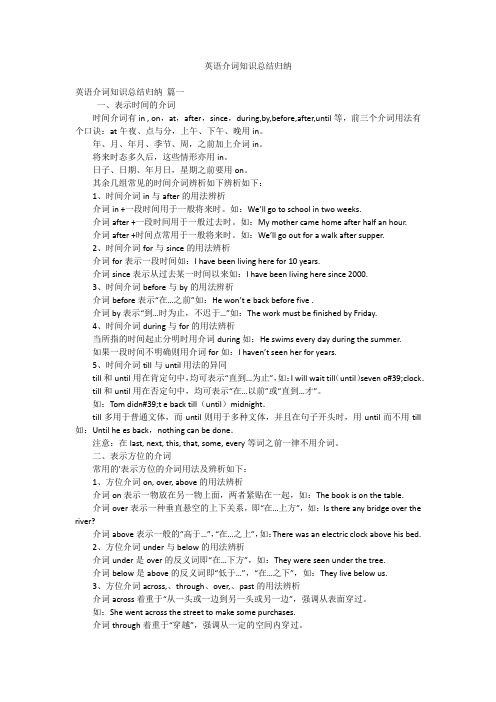
英语介词知识总结归纳英语介词知识总结归纳篇一一、表示时间的介词时间介词有in , on,at,after,since,during,by,before,after,until等,前三个介词用法有个口诀:at午夜、点与分,上午、下午、晚用in。
年、月、年月、季节、周,之前加上介词in。
将来时态多久后,这些情形亦用in。
日子、日期、年月日,星期之前要用on。
其余几组常见的时间介词辨析如下辨析如下:1、时间介词in与after的用法辨析介词in +一段时间用于一般将来时。
如:We’ll go to school in two weeks.介词after +一段时间用于一般过去时。
如:My mother came home after half an hour.介词after +时间点常用于一般将来时。
如:We’ll go out for a walk after supper.2、时间介词for与since的用法辨析介词for表示一段时间如:I have been living here for 10 years.介词since表示从过去某一时间以来如:I have been living here since 2000.3、时间介词before与by的用法辨析介词before表示“在…之前”如:He won’t e back before five .介词by表示“到…时为止,不迟于…”如:The work must be finished by Friday.4、时间介词during与for的用法辨析当所指的时间起止分明时用介词during如:He swims every day during the summer.如果一段时间不明确则用介词for如:I haven’t seen her for years.5、时间介词till与until用法的异同till和until用在肯定句中,均可表示“直到…为止”,如:I will wait till(until)seven o#39;clock.till和until用在否定句中,均可表示“在…以前”或“直到…才”。
介词的含义及用法
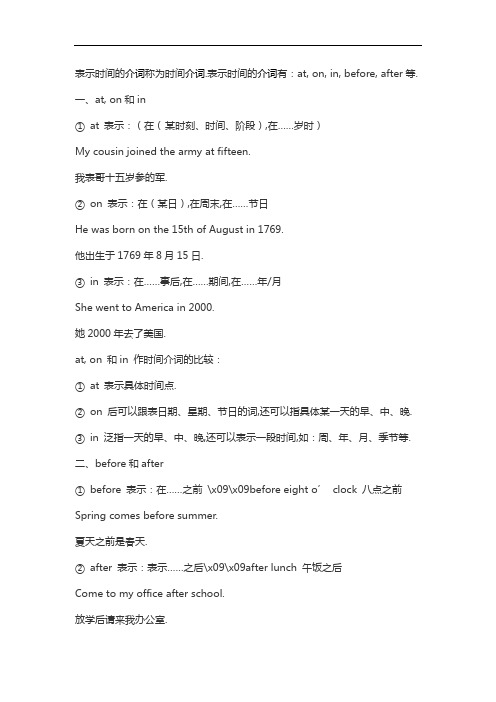
表示时间的介词称为时间介词.表示时间的介词有:at, on, in, before, after等.一、at, on和in①at 表示:(在(某时刻、时间、阶段),在……岁时)My cousin joined the army at fifteen.我表哥十五岁参的军.②on 表示:在(某日),在周末,在……节日He was born on the 15th of August in 1769.他出生于1769年8月15日.③in 表示:在……事后,在……期间,在……年/月She went to America in 2000.她2000年去了美国.at, on 和in 作时间介词的比较:①at 表示具体时间点.②on 后可以跟表日期、星期、节日的词,还可以指具体某一天的早、中、晚.③in 泛指一天的早、中、晚,还可以表示一段时间,如:周、年、月、季节等.二、before和after①before 表示:在……之前\x09\x09before eight o’clock 八点之前Spring comes before summer.夏天之前是春天.②after 表示:表示……之后\x09\x09after lunch 午饭之后Come to my office after school.放学后请来我办公室.表示做某事的方法、手段的介词有by, with, in, at, on.一、byby表示:用,以,靠,通过……方式.by表示手段时后接动作或制作方式.“by + 交通工具”表示交通方式.by bike 骑车\x09by bus 坐公车\x09by taxi 搭出租by train 坐火车\x09by ship 乘船\x09by air 坐飞机Linda usually goes to work by subway.琳达通常做地铁上班.She makes a living by teaching.她考教书谋生.二、withwith 表示:用,以.with表示手段时,后接工具、材料或具体内容.write with a pen 用钢笔写eat with knife and fork 用刀叉吃see with one’s eyes 用眼睛看I killed the fly with a swatter.我用苍蝇拍打死那只苍蝇.She cut the cake with a knife.她用刀切开了蛋糕.三、inin 表示:用,以.in表示用某种方式,如:颜色、笔墨、语言、声音、服饰等.speak in English 用英语说talk in a high voice 高声说话I wrote a letter in ink.我用钢笔写了一封信.Try to express yourself in English.试着用英语表达一下.表示空间的介词有:at, in, on, over, above, under, below 等表示静态位置的介词和from, to, up, down, through, across 等表示动态方向的介词.一、at, on 和in①at 表示:(地点、位置)在……②on 表示:(位置)在……上面③in 表示:(地点、位置或空间)在……里,在……中,在……上Her fans have arrived at the airport.她的影迷已经到达了机场.Look at the picture at the top of the page.请看以下这一项上面的图片.Is my pen on the desk or in the desk?我的钢笔是在桌子上还是在抽屉里呢?Some kids are playing in the yard and others are playing in the room. 有些孩子在院子里玩,其他则在房间里玩.at,on 和in 作空间介词的比较①at用于表示一个较小的场合,这个地点被当作一个点来看待.②on 表示在某一平面或线上,强调与某物体有接触.③in 表示在较大的地方,在某立体空间或平面范围之内.二、about 和around①over 二者都表示:在……周围/各处,围绕.但②above about强调无方向.We walked about in the town.我们在城里到处游逛.Dudu is running around the fence.嘟嘟在绕着篱笆跑.Let’s plant trees around the house.让我们在房子周围栽上树.三、over 和above①under 表示:在……正上方,越过②above 表示:在……上方I saw a wood bridge over the river.我看见河上有座木桥.Look! Some birds are flying above the clouds.看!一些鸟儿在云朵上飞翔.over和above作空间介词的比较①over强调在某人或某物的正上方,而且两物体表面没有接触.②above 强调位置上某物体的上方,并不一定是正上方,而且两物体表面也没有接触.四、under 和below①under 表示:在……的正下方②below 表示:在……下方Please read the words below the picture.请读图片下面的文字.Look! A big mouse hides under the armchair.看!一只大老鼠躲在扶手椅下面.under 和below 作空间介词的比较①under 强调在某物的下方,完全覆盖两物体表面可以接触也可以不接触.②below 强调位置低于某参照物,但并不一定是正下方.五、between 和among①between 表示:(位置、时间、数量等)在……之间(两者之间)②among 表示:在……中间(三者或三者以上之间)I often fly between Beijing and Shanghai.我经常在北京和上海之间飞来飞去.Come here between eight and nine o’clock.请把点到九点之间过来.Susan is among the crowd.苏珊是人群当中.六、into 和out of①into 表示:进来②out of 表示:出去Get out of the room.从房间里出去!Bob walked into the room.鲍勃走进房间.He is working in the office.她在办公室里工作.七、behind 和in front of①behind 表示:在……后面②in front of 表示:在……前面There is a fountain in the front of the park.公园的前面有一个喷泉.Susan sits in front of me and Dudu sits behind me. 苏珊坐在我前面,嘟嘟坐在我后面.八、up 和down①up 表示:往上,向……顶上②down 表示:往下,沿着……往下The monkey is climbing up the tree.猴子正在往树上爬.Tears ran down her face.眼泪从她的脸上流了下来.九、across 和through①across 表示:穿过,跨过②through表示:穿过,通过There is a bridge across the river there.那儿有座桥横跨在河上.A train is running through the tunnel.一列火车正从隧道中穿过.十、by 和near①by 表示:在……旁边②near 表示:在……附近Come over here and stand by me.过来站在我旁边吧.We are planning to camp by the lake.我们打算到湖边露营.There are some big apple trees near the house. 房子附近有一些大苹果树.The new hospital is near our school.新医院里我们学校不远.十一、其他空间介词①along 表示:沿着,顺着②to 表示:到……,去……,向……Let’s walk along the street.让我们沿着街散散步.We drove along the freeway.我们驱车沿着高数公路行驶.The child pointed to the polar star.那孩子指着北极星.I’m going to the bakery.我想要去那家糕饼店.*第一个to表示“指”的方向、目标.第二个to表示到达的目的地.除了按上面介绍表示时间关系、空间关系、方式、手段等的介词外,还有一些重要的介词:一、of 的用法①of 表示:……的(表示所属、所有关系)a cover of this book这本书的封皮a friend of my parents我父母的一个朋友②of 表示:……之中的(表示部分)some boys of the team小组里的几个男生the end of the story故事的结尾Two students of our class joined in the match.我们班里的两个同学参加了这场比赛.All of us approved his plan.我们全都赞成他的计划.③of 表示:……份/量的,……的种类的(表示量、种类)a drop of water一滴水a pair of shoes一双鞋I want two cups of coffee.我要两杯咖啡.二、with 的用法①with 表示:具有,有……的,随身带着It is a dog with black spots.它是一只长着黑色斑点的狗.Take an umbrella with you.带把雨伞吧!②with表示:和……一起,同……一起,偕同I went to Disneyland with my mother.我和妈妈一起去了迪斯尼乐园.Jane likes to play with Mimi.简喜欢和咪咪玩耍.③with 表示:随着……The wine improves with age.这种酒越陈越香.I get up with the sun every day.我每天日出就起床.三、for 的用法①for 表示:为了……(表示目的、用途、利益)Give me a knife for cutting bread.给我一把切面包的刀子.I’ve found it for you.我已经为你找到了它.What can I do for you?我能为你做些什么吗?②for 表示:一段距离或时间He has run for a mile.他跑了一英里.I’ve studied in Beijing for three years.我在北京学习三年了.Please bake the cake for 40 minutes.请将蛋糕烤四十分钟.③for 表示:因为,由于(表示原因)Thank you for your help.谢谢你的帮助.Andy jumped for joy at the good news.安迪听到这个消息高兴的跳了起来.We could hardly see for the mist.由于大雾,我们几乎看不见了.四、like 的用法①like表示:像……(一样),似……(一样)They are like brothers and sisters.他们情同手足.②like 表示:是什么样子,怎样Andy looks just like his father.安迪和他爸爸像极了.五、from 的用法①from 表示:(时间或场所)从……,自……We work from Monday to Friday.我们周一到周五上班.Charlie will fly from New York to London.查理要从纽约飞往伦敦.The cat jumped down from the top of the wall. 猫从墙头跳了下来.②from 表示(两地的距离)离The nearest hospital is 10 miles from my house.最近的医院离我家十英里远.We live about 5 kilometers from Boston.我们住在离波士顿约五公里的地方.③from 表示:出自……,来自……Did you have a (phone) call from him?你接到他的电话了吗?Where are you from?你来自哪里?Susan got a letter from her aunt.苏珊收到一封她姨妈的来信.六、at, about, to 和in 的其他用法①at 表示:对着……, 朝着……,向……(表示方向,目标)He threw a bone at the dog.他用一块骨头砸狗.Please look at the blackboard.请看黑板.Jack shot at the deer but missed.杰克朝鹿开了一枪,但是没有打中.②about 表示:关于……,涉及……He told me a story about ghosts.他给我讲了一个鬼故事.Don’t worry about me.不要担心我.They are talking about English learning. 他们在谈论英语学习.③to 表示:对于,给,向(表示对象)Jane is always very kind to others.简总是对别人很友善.Please send some food to them.请给他们送些食品去.Have you told all the news to John?你把全部的消息都告诉约翰了吗?④in 表示:穿着,戴着Who is the man in black?那穿黑色衣服的人是谁?Tom is in a purple hat.汤姆戴着紫色帽子.The girl in uniform is Mary.穿校服的那个女孩是玛丽.。
介词短语的用法表示时间地点方式

介词短语的用法表示时间地点方式介词短语在英语中是非常常见且重要的一种语法结构。
它由一个介词和其后的名词组成,用来表示时间、地点以及方式。
掌握介词短语的正确使用,对于准确表达自己的意思非常关键。
本文将介绍介词短语的用法,并举一些例子加以说明。
一、时间1. 表示具体时间点介词短语可以用来表示具体的时间点,常用的介词有at, on, in。
例如:- I will meet you at 6 o'clock.- The meeting is on Monday.- My birthday is in September.2. 表示时间段介词短语还可以用来表示时间段,常用的介词有for, during, over。
例如:- We will go on vacation for two weeks.- I worked late during the night.- He finished the project over the weekend.二、地点1. 表示具体地点介词短语可以用来表示具体的地点,常用的介词有at, in, on。
例如:- She is waiting for you at the park.- The restaurant is in the city center.- The book is on the table.2. 表示方向介词短语还可以用来表示方向,常用的介词有to, from, towards。
例如:- I am going to the library.- He came back from school.- We walked towards the beach.三、方式介词短语可以用来表示方式或方式手段,常用的介词有with, by, through。
例如:- She brushes her teeth with a toothbrush.- I will do it by myself.- They solved the problem through teamwork.四、其他常用介词1. about表示大约、关于- There are about 50 students in the class.- Let's talk about the movie.2. for表示为了、对于- I bought a gift for my friend.- This book is for children.3. of表示属于、关于- The house at the end of the street is mine.- He is the president of the company.4. with表示带有、用- She has a bag with a zipper.- He writes with a pen.综上所述,介词短语在英语中用来表示时间、地点和方式,是非常重要的语法结构。
介词表示时间的7个用法
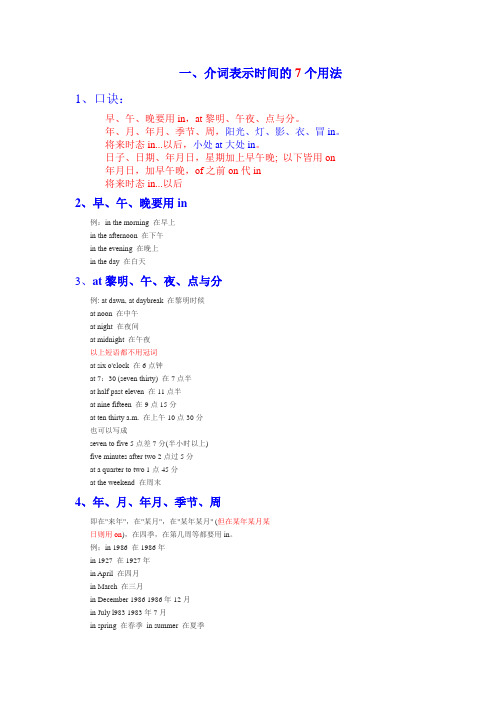
一、介词表示时间的7个用法1、口诀:早、午、晚要用in,at黎明、午夜、点与分。
年、月、年月、季节、周,阳光、灯、影、衣、冒in。
将来时态in...以后,小处at大处in。
日子、日期、年月日,星期加上早午晚; 以下皆用on年月日,加早午晚,of之前on代in将来时态in...以后2、早、午、晚要用in例:in the morning 在早上in the afternoon 在下午in the evening 在晚上in the day 在白天3、at黎明、午、夜、点与分例: at dawn, at daybreak 在黎明时候at noon 在中午at night 在夜间at midnight 在午夜以上短语都不用冠词at six o'clock 在6点钟at 7:30 (seven thirty) 在7点半at half past eleven 在11点半at nine fifteen 在9点15分at ten thirty a.m. 在上午10点30分也可以写成seven to five 5点差7分(半小时以上)five minutes after two 2点过5分at a quarter to two 1点45分at the weekend 在周末4、年、月、年月、季节、周即在"来年",在"某月",在"某年某月" (但在某年某月某日则用on),在四季,在第几周等都要用in。
例;in 1986 在1986年in 1927 在1927年in April 在四月in March 在三月in December 1986 1986年12月in July l983 1983年7月in spring 在春季in summer 在夏季in autumn 在秋季in winter 在冬季in the fist week of this semester 这学期的第一周in the third week 在第三周5、日子、日期、年月日,星期加上早午晚; 以下皆用on。
介词用法
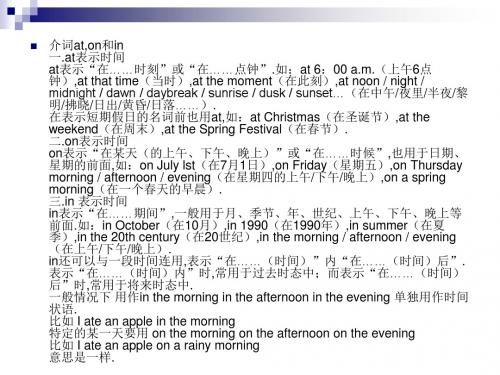
介词at,on和in 一.at表示时间 at表示“在……时刻”或“在……点钟”.如:at 6:00 a.m.(上午6点 钟),at that time(当时),at the moment(在此刻),at noon / night / midnight / dawn / daybreak / sunrise / dusk / sunset…(在中午/夜里/半夜/黎 明/拂晓/日出/黄昏/日落……). 在表示短期假日的名词前也用at,如:at Christmas(在圣诞节),at the weekend(在周末),at the Spring Festival(在春节). 二.on表示时间 on表示“在某天(的上午、下午、晚上)”或“在……时候”,也用于日期、 星期的),on Thursday morning / afternoon / evening(在星期四的上午/下午/晚上),on a spring morning(在一个春天的早晨). 三.in 表示时间 in表示“在……期间”,一般用于月、季节、年、世纪、上午、下午、晚上等 前面.如:in October(在10月),in 1990(在1990年),in summer(在夏 季),in the 20th century(在20世纪),in the morning / afternoon / evening (在上午/下午/晚上). in还可以与一段时间连用,表示“在……(时间)”内“在……(时间)后”. 表示“在……(时间)内”时,常用于过去时态中;而表示“在……(时间) 后”时,常用于将来时态中. 一般情况下 用作in the morning in the afternoon in the evening 单独用作时间 状语. 比如 I ate an apple in the morning 特定的某一天要用 on the morning on the afternoon on the evening 比如 I ate an apple on a rainy morning 意思是一样.
英语高中语法介词的用法和常用介词的区别

英语高中语法介词的用法和常用介词的区别高中英语语法:介词的5种用法1. 时间1)at表示在某一时间点: at 3 o’clock2)in表示在某一时间段内的某一或某些点: in 2004in表示在某段时间的结束点:I’ll see you again ina week.3) during表示某一时间段内自始至终:during thefirst period4) on表示在某一day/date或其中的某一段:on Monday, on Sunday morning5) by表示不迟于某个时间:by now2. 地点1)at表示在某处(而非它处):at school2) in表示在内部或某个范围内:in the office3) on表示在上面与某平面接触:on the table4) outside表示在某个范围之外:outside world5) under表示在比某个位置低的地方或在某表面之下:under a chair6) by表示靠近或接近:by the window3. 原因1)because of表示因为或以…为理由:because of my father2) for表示动作或活动的目的、目标或意图:for sale3) out of表示起源、来源或原因:out of duty4. 方式1)with表示以…方式:with skill2)in表示以某种方式: in French, in cash, in this way5. 方法1) by表示方法、手段: by the back road, by bus, by working hard2) on表示运送方式:on a train, on foot3) in表示途径或材料:in oils高中英语语法中常用介词的区别1、 at、in、on:如:常用词组有: at noon, at night表示时间的 at, in, on:at 表示片刻的时间,at 8 o’clock,at midnight, at the end of, at that time, at the beginning of, at the age of, at Christmas, at New Year 等。
英语介词in、on、at等的用法大全

英语介词in、on、at等的用法大全“表时间的介词at、on、in到底怎么用?",今天接着跟大家分享这三个介词表时间的用法.一、at1、表示时刻,即几点几分(with particular points on the clock)I’ll see you at five o’clock。
(我五点和你见面。
)2、表示一天中的某个时间段(with particular points in the day)The helicopter took off at midday and headed for the island。
(直升机中午起飞,飞往那个岛屿.)3、表示一周中的某个时间段,即工作日(weekday)和周末(weekend)(with particular points in the week)What are you doing at the weekend?4、表示某种特殊场合,如名字中不含day的节假日(with special celebrations)At the New Year, millions of people travel home to be with their families(到了新年,成百上千万的人会回到家里和家人团聚。
)例外情况:如果是说在生日那天,不用at,而用on,因为生日那天是指具体日期,请往下参考on 的用法.【注意】如果是用what time来提问,what time前面一般不用at。
如:What time are you leaving?(你几点走?) 但是在口语中也可以这么问:At what time are you leaving?二、on1、用在日期前(with dates)We moved into this house on 2 October 1997。
(我们是1997年10月2日搬进这栋房子的。
)2、用在星期的单数前(with a singular day of the week to refer to one occasion)I’ve got to go to London on Friday. (我周五就到伦敦了.)3、用在星期的复数前(with a plural day of the week to refer to repeated events)The office is closed on Fridays. (办公室周五是关门的。
常用介词的用法归纳

常用介词的用法归纳常用介词的用法归纳一、表示时间1. at, in, on “在…..”at表示在某一时刻及中午,夜间:at eight, at noon, at midnight, at the weekend in 表示一段时间,通常用于世纪,年,季,月,早,中,晚in1921, in Spring, in September, in the morning/ afternoon/ eveningon表示在具体的某一天或有具体特征的某一天的早中晚on Sunday, on September 29th, on Christmas Eve,on National Day, on Sunday morning2. since, from, after “自…..”since"自从….以来,表示时间的继续,常与现在完成时,现在完成进行时一起使用如: She has lived here since 2002. / for six years.from自….起,表示某事开始的时间I began to learn English from childhood. after 在….以后, we went out for a walk after dinner.3. to, before, by, till/until “到……”to “到……”,表示时间的终点,与表示起点的from相对如: I didn’t stay to the end of the meeting.We have classes from Monday to Saturday.before “在……以前”,指某事或某时间前的情况Wash your hands before dinner. by “最迟在…….之前”,表示某事完成的期限,须与非持续性动词连用如: Can you finish the work by tomorrow? (非持续性动词)till/until “直到……”,表某事持续到某时或另一件事发生为止如: They waited until 10:00. (持续性动词)They didn’t leave until 10:00. (与非持续性动词连用时,要用否定not)4. in, within, after “在……内/后”in “再过”,接时间段,表示将来意义,用于将来时态如: She’ll be back in half an hour.within “在…..之内”,表示在某时间段内,无时态限制. 如:within 3 hours after “过……,经过….后”, 后可接时间点和时间段,常用将来时或过去时如: He’ll leave after 10:00.He left after 11:00.He left after a few hours.二、表示地点或方位1.at, in “在”at表示较狭小的地点或较小的地名They arrived at the village at 10:00.in表示宽阔的地点或较大的地名They arrived in China yesterday.2.at, to “向……”at表示以某一点为目标,常与动词连用He threw the ball at that boy.to仅表动作的方向Throw it to me.如: point at 和point to3.on/upon, over, above, up“在……上” on表有表面接触的状态over表在正上方,无接触的above表在斜上方,无接触的up表示从下往上;与down相反如:Stand up!4.under, below, down “在…..下”under在某物的正下方,与over的意思相反below在某物的斜下方,与above相反down从上往下的运动,与up相反如:Sit down!如:The book is on the desk. 书在桌子上The light is above the desk. 灯在桌子斜上方 The desk is over the ball. 桌子在球的正上方 The ball is under the desk. 球在桌子正下方The desk is below the light. 桌子在灯的斜下方 5.between, among “在…..之间”between在二者之间I sat between Tom and Jack.There is no difference between them.among在三者或更多之间There is a small house among the trees.注意:如果强调两两相互间的关系,常用between;而把它们视为分居两边时用between;在谈事物间的差别时,总是用between ( tell the differences betweenA and B)6.along, across, throughalong沿着,指沿着一定路线的水平方向的运动如: We walked along the road. Trees grew along the river bank.across横过,从一边到另一边的运动(到对面)如: You mustn’t go across the street when red light is on. (到街的对面去) through穿过,指从一定空间中穿过如: through the forestsThe train is running through a tunnel. I threw it through the window.三、表示材料表示材料常用的短语:1.成品+ be made of/from + 原材料(of表在成品中可看见原材料的性质; from则已看不出原材料) 如: The desk is made of wood. / The paper is made from wood.2. make sth(成品) out of sth(原材料) 如: We make bottles out of glass.3. make sth(原材料) into sth(成品) 如: we make glass into bottles.四、其他用法1.besides, except, but, except forbesides指”除了…..还有(包含在内)except指除了….外,不能放在句首(不包括在内)如: Do you know any other foreign language besides English?I know English, French except Japanese.bu t与except意思相似,表示除了…..外,常用于no, all, nobody, anywhere, everything等及疑问词之后如: The children go to school everyday but Sunday.except for“如无…..就”;总体…..,只是…..”,用于说明总体中的某个细节2.in, withwith表示工具的”用” ,in表示材料、方式、方法、度量、单位、语言、声音等的“用“如: Write with a pen.Write in ink.You’d better deal with the problem in this way.Please say it in English.He said it in a loud voice.3.on , about表示“关于”on一般用于比较大或涉及比较深的问题, 比较正式的或学术的论述; about用于表示一般的问题如: This is a little story about a little hero. He will give us a talk on DNA.4.by表示坐某种交通工具,或取陆路、水路等方式如: by plane/ car/ ship/ air/ sea…..。
40个英语介词用法总结
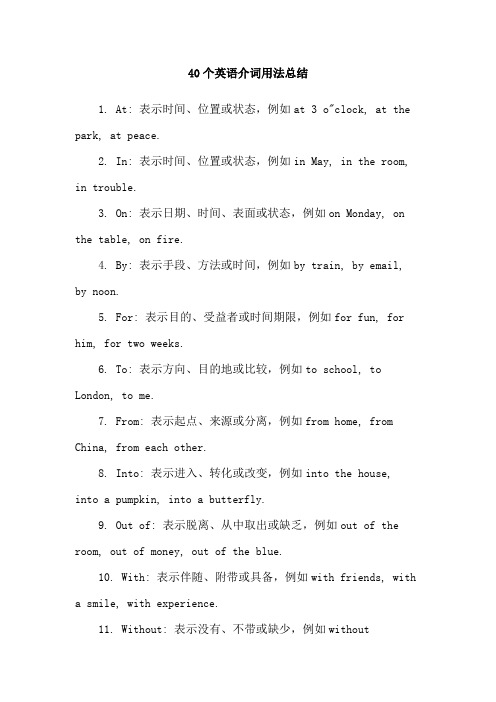
40个英语介词用法总结1. At: 表示时间、位置或状态,例如at 3 o"clock, at the park, at peace.2. In: 表示时间、位置或状态,例如in May, in the room, in trouble.3. On: 表示日期、时间、表面或状态,例如on Monday, on the table, on fire.4. By: 表示手段、方法或时间,例如by train, by email, by noon.5. For: 表示目的、受益者或时间期限,例如for fun, for him, for two weeks.6. To: 表示方向、目的地或比较,例如to school, to London, to me.7. From: 表示起点、来源或分离,例如from home, from China, from each other.8. Into: 表示进入、转化或改变,例如into the house,into a pumpkin, into a butterfly.9. Out of: 表示脱离、从中取出或缺乏,例如out of the room, out of money, out of the blue.10. With: 表示伴随、附带或具备,例如with friends, witha smile, with experience.11. Without: 表示没有、不带或缺少,例如withoutpermission, without shoes, without doubt.12. Over: 表示覆盖、超过或结束,例如over the roof, over the limit, over and done with.13. Under: 表示在下面、被支配或不足,例如under the table, under his control, under budget.14. About: 表示关于、大约或忙于,例如about the movie, about 10 dollars, about to leave.15. Above: 表示在上面、高于或超过,例如above the clouds, above average, above suspicion.16. Below: 表示在下面、低于或不足,例如below the surface, below freezing, below par.17. Across: 表示横穿、相交或涉及,例如across the street, across the board, across his mind.18. Beyond: 表示超出、远离或除了,例如beyond repair, beyond belief, beyond her control.19. Around: 表示周围、附近或环绕,例如around the corner, around the clock, around the world.20. Before: 表示以前、在前面或比较,例如before noon, before the house, before his time.21. Behind: 表示在后面、落后或背后,例如behind the house, behind schedule, behind the scenes.22. Beside: 表示在旁边、与...相比或附加,例如besidethe river, beside myself, beside the point.23. Inside: 表示内部、在里面或被包含,例如inside the box, inside the building, inside information.24. Outside: 表示外部、在外面或超出,例如outside the house, outside the box, outside the norm.25. Through: 表示穿过、经过或完成,例如through the door, through the park, through with it.26. Throughout: 表示遍布、贯穿或在整个期间,例如throughout the city, throughout history, throughout the day.27. Towards: 表示朝向、对于或接近,例如towards the sun, towards him, towards the end.28. Against: 表示反对、抵抗或紧挨着,例如against the law, against the current, against the wall.29. Among: 表示在...之中、相互之间或被分配到,例如among friends, among the stars, among the winners.30. Between: 表示在两者之间、在中间或相互之间,例如between two trees, between classes, between you and me.31. Within: 表示在内部、在范围之内或在规定时间内,例如within the house, within the budget, within a week.32. Without: 表示在外面、没有或不用,例如without the room, without a doubt, without further ado.33. Beneath: 表示在下面、低于或不足,例如beneath the surface, beneath his dignity, beneath contempt.34. Beside: 表示在旁边、与...相比或附加,例如beside the river, beside myself, beside the point.35. Into: 表示进入、转化或改变,例如into the house, into a pumpkin, into a butterfly.36. Upon: 表示在...之上、一旦发生或基于,例如upon the hill, upon arrival, upon further consideration.37. With: 表示伴随、附带或具备,例如with friends, witha smile, with experience.38. Within: 表示在内部、在范围之内或在规定时间内,例如within the house, within the budget, within a week.39. Without: 表示没有、不带或缺少,例如without permission, without shoes, without doubt.40. Beneath: 表示在下面、低于或不足,例如beneath the surface, beneath his dignity, beneath contempt.。
表示时间介词用法

*on表示“在……时候”,与日期、星期搭配使用。如: I leave on Monday 25th November. He plays football on Friday. *in表示“在……期间”,与具体的年代、月份、季节或一天中的某个时段搭配使用。如: The postman comes in the morning(s) and in the afternoon(s).邮递员每天上午和下午来送信。 注意:on Monday与on Mondays意义不完全相同。on Monday有两个意思,第一表示特指的某个星期一,第二表示每逢星期一;而on Mondays只表示每逢星期一。
4.描述情感
描述情感或感受,常用动词to feel. 如: -How are you feeling? -I feel much better. Thank you. 你现在感觉怎么样?我觉得好多了。谢谢你。 -How do you feel today? -I feel terrible. I’ve got a headache. 你今天感觉怎么样?我觉得很难受。我头疼。
注意:以下名词与介词的固定搭配:
2.时间表达法
this/next/the…after 可以表达时间,如: this month(这个月)/next month(下个月)/the month after next(下下个月) this Tuesday/next Tuesday/the Tuesday after next this week/next week/the week after next this year/next year/the year after next today/tomorrow/the day after tomorrow 注意:the next day 表示 过去 的时间,意为“第二天”而不是明天,常常用在间接引语里。
英语语法介词用法
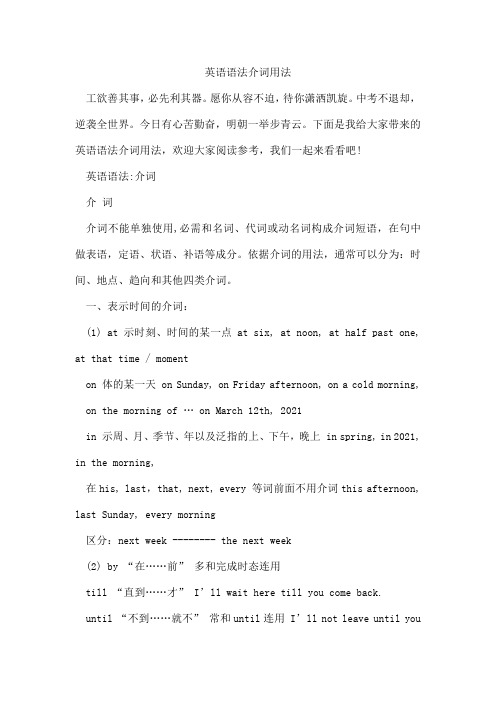
英语语法介词用法工欲善其事,必先利其器。
愿你从容不迫,待你潇洒凯旋。
中考不退却,逆袭全世界。
今日有心苦勤奋,明朝一举步青云。
下面是我给大家带来的英语语法介词用法,欢迎大家阅读参考,我们一起来看看吧!英语语法:介词介词介词不能单独使用,必需和名词、代词或动名词构成介词短语,在句中做表语,定语、状语、补语等成分。
依据介词的用法,通常可以分为:时间、地点、趋向和其他四类介词。
一、表示时间的介词:(1) at 示时刻、时间的某一点 at six, at noon, at half past one, at that time / momenton 体的某一天 on Sunday, on Friday afternoon, on a cold morning, on the morning of … on March 12th, 2021in 示周、月、季节、年以及泛指的上、下午,晚上 in spring, in 2021, in the morning,在his, last,that, next, every 等词前面不用介词this afternoon, last Sunday, every morning区分:next week -------- the next week(2) by “在……前” 多和完成时态连用till “直到……才” I’ll wait here till you come back.until “不到……就不” 常和until连用I’ll not leave until youcome back.(3) in 过……以后, 大多用于将来时 after 多用于过去时(4) since + 过去的一个时间点 (表示时间段, 从……开头到现在) for + 一段时间二、表示场所、方向的介词:(1)at 表示比较详细的地点 at 37 Renming Roadin 表示比较宽敞的地点 in Renming Street(2)above斜上方-------below斜下方 over正上方-------under正下方on 两物体有接触(3) be tween…and..在……和……之间 among在……中间(三者以上)(4) across (从物体表面)跨越, 越过 through (从物体中间)穿透, 穿越(5)in 在……里面(表示静止的位置) into 进入,表示运动方向,常用在表示动作的动词之后, 如 go, come, walk, jump, run 等 into的反义词是out of(6)to 到 (目底地)或方向 towards 指朝着某方向,而不是目的地.He walked towards the beach.三、其它介词1.with (1)在一起; (2)有; (3)用某种工具in 用什么材料或语言,或表示衣着,声调特点等by 用......手段2.Like 象......一样as 作为;根据,象......一样(连词)+ 句子3.for(1)为了(表示目的或缘由) (2)(后面加一段时间)表示时间段英语中考:介词短语[介词短语聚焦]“介词+名词/代词”所构成的短语称为介词短语。
常用介词的用法

常用介词的用法介词可以用来表示时间、空间、方位、手段等含义,其具体用法如下:表示时间表示时间的介词主要有at, on,in, during,for, since,after, before 等.①atat 表示在某一具体时刻,或把某一段时间看作某一时刻时也可用at。
在节假日也常用at。
at 7:30 在七点半at noon 在正午at that time 在那时at first 首先at the end of 在……最后at the beginning of 在……开始时at the moment 当时、这时at the present (time) 目前at Christmas 在圣诞节at midnight 在半夜at breakfast time 在吃早饭时at the beginning 开始at present 目前②on当表示在具体的某一天,某一天的早晨、中午或晚上时常用介词on;对某一天或某一天的早晨、中午或晚上进行详细描述时也用on。
on Monday 在星期一on May the first 在五月一日on a rainy day 在雨天on Monday morning 在星期一早晨on the following evening 在第二天傍晚on the morning of April the first 在四月一日上午on the following day 在第二天on New Year’s Day 在元旦on a cold day 在寒冷的一天on the weekend 在周末③in当所指的时间比一天更长或更短时用介词in. in还可表示在将来,用在从现在算起的一段时间之后.in the evening 在傍晚in spring 在春季in the 21st century 在二十一世纪in the 1990’s 在二十世纪90年代in my school days 在我上学期间in August 在八月in 2004 在2004年in one's life 在一生中in the future 在将来in the daytime 在白天④duringduring 除了具有in表示时间段的功能之外,还可指在某一项活动的过程中。
介词的用法大全

介词的用法一.表示时间日期的介词1. at:主要表示方向、场所、时间的某一点at the corner of the street,at dinner,at sixty miles an hour,be sold at three yuan a dozen,come at us固定搭配: at one time, at the beginning of, at the post office, at the airport, at the weekend,at the age of 25,at the same time, at present,at any time,表示原因,表示“见/闻……而”。
at the newsat 主要表示时间点表示特定的时间 at night a.m. 在九点钟表示不确定的时间 at night, at that time, at Christmas 在圣诞期间当天 on表示年龄段 at the age of eight 在 8 岁2. in:表示场所、时间与期限、状况、方向。
主要用来表示较长的时间单位,如月份、季节、年份等in the 1990s in the late 19th century形成“in+时段名词”的词组或固定搭配in those days,in the daytime,in a short while,in no time,in time.in 主要表示时间段一般指相对较长的时间段里 in the morning, in spring, in the past ten years在…时间之后,用于将来时 He will be back in a month.介词 in 在短语或句型中的省略:1) 某些形容词/过去分词后接 v-ing 形式时,v-ing 形式前的介词 in 可以省略。
be busy (in) doing be engaged (in) doing (忙于……)2) 某些动词如 busy 等,常与反身代词连用,其后的 in 也可以省略。
初中英语语法:英语介词口诀详解
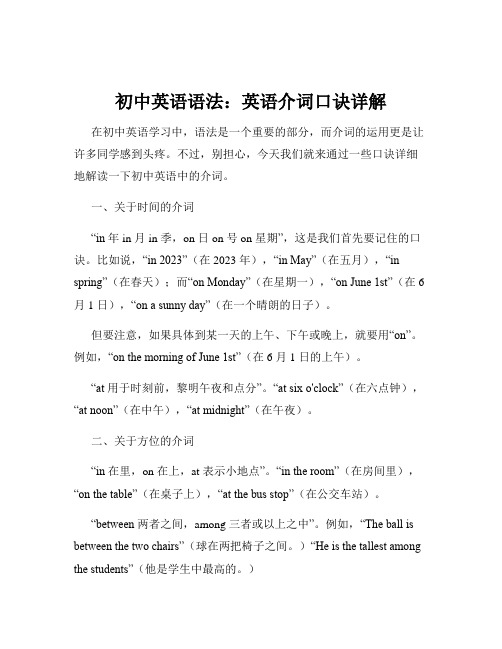
初中英语语法:英语介词口诀详解在初中英语学习中,语法是一个重要的部分,而介词的运用更是让许多同学感到头疼。
不过,别担心,今天我们就来通过一些口诀详细地解读一下初中英语中的介词。
一、关于时间的介词“in 年 in 月 in 季,on 日 on 号 on 星期”,这是我们首先要记住的口诀。
比如说,“in 2023”(在 2023 年),“in May”(在五月),“in spring”(在春天);而“on Monday”(在星期一),“on June 1st”(在 6 月 1 日),“on a sunny day”(在一个晴朗的日子)。
但要注意,如果具体到某一天的上午、下午或晚上,就要用“on”。
例如,“on the morning of June 1st”(在 6 月 1 日的上午)。
“at 用于时刻前,黎明午夜和点分”。
“at six o'clock”(在六点钟),“at noon”(在中午),“at midnight”(在午夜)。
二、关于方位的介词“in 在里,on 在上,at 表示小地点”。
“in the room”(在房间里),“on the table”(在桌子上),“at the bus stop”(在公交车站)。
“between 两者之间,among 三者或以上之中”。
例如,“The ball is between the two chairs”(球在两把椅子之间。
)“He is the tallest among the students”(他是学生中最高的。
)“in front of 外部的前面,in the front of 内部的前面”。
“There is a tree in front of the house”(房子前面有一棵树。
)“The teacher i s standing in the front of the classroom”(老师站在教室的前面。
介词的用法专题知识
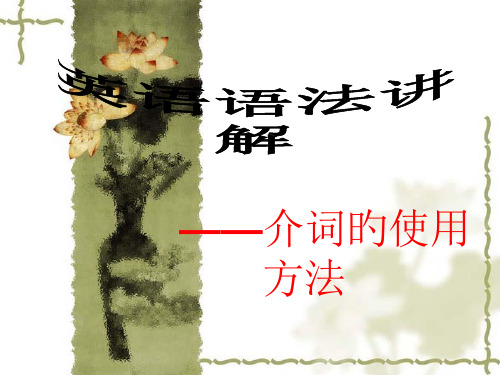
一、定义
介词preposition缩写prep.,又叫前置词,表达其后 旳名词或代词(或是相当于名词旳其他短语或从句) 与其他句子成份旳关系。介词是一种虚词,不能单独 在句中作成份。
二、介词旳使用方法
1、表达时间旳(at 、on、in、at、before ,after、 by、 until、through、from、since、within)
(1) at:在某地点(表达比较狭窄旳场合) at school上学 at home在家 at 320 Xinfu District 在新抚区320
号at the station 在火车站
(2)in:在某地(表达比较宽阔旳场合) She will arrive in Shanghai at ten .10点她将到达上海。
(3)表达地点方向旳on ,under ,over ,above ,below ①on:在……上面,有接触面 on the table 在桌子上面 ②above:在……上方 Sometimes Juliana could hear planes above the trees. 有时朱莉安娜能听到树林上空旳飞机声。
③as:作为 They are carrying us as passengers.它们把我们看成乘客
运载着。
(3)against:反对。靠着 Everyone tried to fight against the locusts .全部
旳人奋力扑打蝗虫。
(4) about: ① 有关,各处,四面 Nightingale wrote a book about nursing .南丁格
(1)at:用于表达时刻,时间旳某一点。 at noon在午时 at night在夜间 at present目
介词时间用法
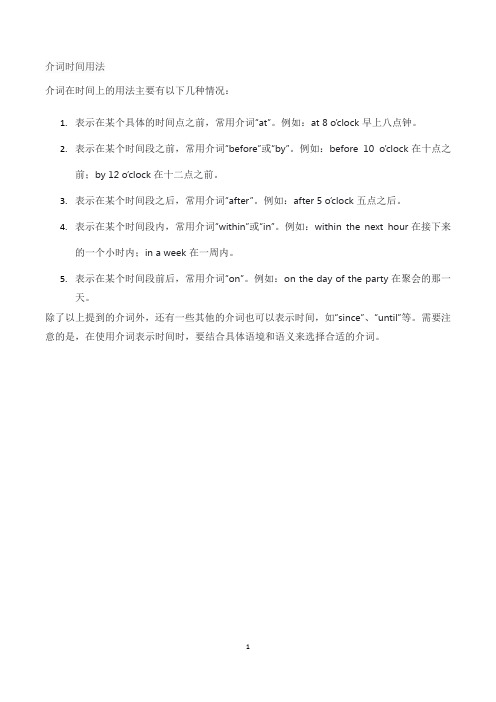
介词时间用法
介词在时间上的用法主要有以下几种情况:
1.表示在某个具体的时间点之前,常用介词“at”。
例如:at 8 o’clock早上八点钟。
2.表示在某个时间段之前,常用介词“before”或“by”。
例如:before 10 o’clock在十点之
前;by 12 o’clock在十二点之前。
3.表示在某个时间段之后,常用介词“after”。
例如:after 5 o’clock五点之后。
4.表示在某个时间段内,常用介词“within”或“in”。
例如:within the next hour在接下来
的一个小时内;in a week在一周内。
5.表示在某个时间段前后,常用介词“on”。
例如:on the day of the party在聚会的那一
天。
除了以上提到的介词外,还有一些其他的介词也可以表示时间,如“since”、“until”等。
需要注意的是,在使用介词表示时间时,要结合具体语境和语义来选择合适的介词。
1。
时间介词at in on的用法

时间介词at in on的用法时间介词at,in,on在英语中用于表示时间的不同方面和情境。
它们在用法上存在一些规律和区别。
下面我将详细介绍它们的用法。
1. at:- 表示具体时间点,常用于某一天的特定时间:- I will meet you at 5 o'clock.- The party starts at midnight.- 表示某个具体时间的时刻:- The train leaves at 7:30 am.- The movie starts at 9:00 pm.2. in:- 表示一段时间的范围,通常用于几天、几个月、几年:- I will see you in a few days.- They are going on vacation in August.- We will have a meeting in two hours.- 表示未来某个时间点或将来的特定时间:- The concert will take place in two weeks.- We are having a party in December.- 表示一天内的某个时间段,例如早晨、下午、晚上:- She likes to exercise in the morning.- We usually have dinner in the evening.3. on:- 用于表示某一天、某一个日期:- I have an appointment on Tuesday.- The party is on July 4th.- 表示某个特定的日期或节日:- I was born on November 11th.- We celebrate Christmas on December 25th.- 表示星期几:- Let's go shopping on Sunday.- They have a meeting on Thursdays.需要注意的是,这些时间介词在某些情况下也可能有其他用法。
at on of的用法
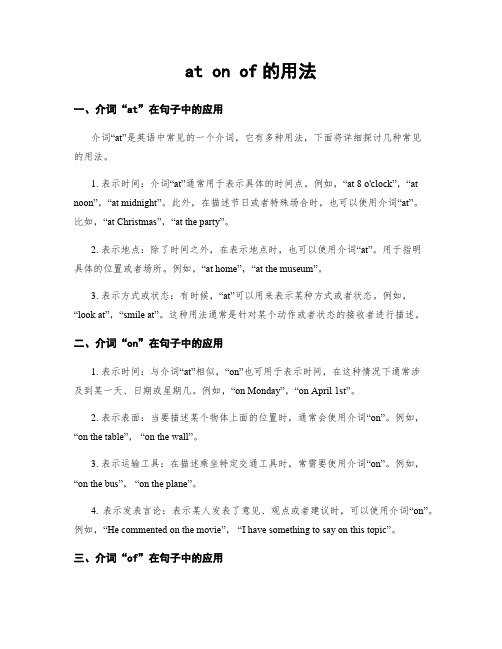
at on of的用法一、介词“at”在句子中的应用介词“at”是英语中常见的一个介词,它有多种用法,下面将详细探讨几种常见的用法。
1. 表示时间:介词“at”通常用于表示具体的时间点。
例如,“at 8 o'clock”,“at noon”,“at midnight”。
此外,在描述节日或者特殊场合时,也可以使用介词“at”。
比如,“at Christmas”,“at the party”。
2. 表示地点:除了时间之外,在表示地点时,也可以使用介词“at”。
用于指明具体的位置或者场所。
例如,“at home”,“at the museum”。
3. 表示方式或状态:有时候,“at”可以用来表示某种方式或者状态。
例如,“look at”,“smile at”。
这种用法通常是针对某个动作或者状态的接收者进行描述。
二、介词“on”在句子中的应用1. 表示时间:与介词“at”相似,“on”也可用于表示时间,在这种情况下通常涉及到某一天、日期或星期几。
例如,“on Monday”,“on April 1st”。
2. 表示表面:当要描述某个物体上面的位置时,通常会使用介词“on”。
例如,“on the table”,“on the wall”。
3. 表示运输工具:在描述乘坐特定交通工具时,常需要使用介词“on”。
例如,“on the bus”,“on the plane”。
4. 表示发表言论:表示某人发表了意见、观点或者建议时,可以使用介词“on”。
例如,“He commented on the movie”,“I have something to say on this topic”。
三、介词“of”在句子中的应用1. 表示所属关系:介词“of”经常被用来表示所属关系。
例如,“the boo k of John”,“the handle of the door”。
这种用法强调某个物体属于或与之相关的人或物。
- 1、下载文档前请自行甄别文档内容的完整性,平台不提供额外的编辑、内容补充、找答案等附加服务。
- 2、"仅部分预览"的文档,不可在线预览部分如存在完整性等问题,可反馈申请退款(可完整预览的文档不适用该条件!)。
- 3、如文档侵犯您的权益,请联系客服反馈,我们会尽快为您处理(人工客服工作时间:9:00-18:30)。
at, in, on, by和through在表示时间上的区别
at, in, on, by和through在表示时间上的区别
1. at指时间表示:
(1)时间的一点、时刻等。
如:
They came home at sunrise (at noon, at midnight, at ten o’clock, at daybreak, at dawn). (2)较短暂的一段时间。
可指某个节日或被认为是一年中标志大事的日子。
如:
He went home at Christmas (at New Year, at the Spring Festival, at night).
2. in指时间表示:
(1)在某个较长的时间(如世纪、朝代、年、月、季节以及泛指的上午、下午或傍晚等)内。
如:
in 2004, in March, in spring, in the morning, in the evening, etc
(2)在一段时间之后。
一般情况下,用于将来时,谓语动词为瞬间动词,意为“在……以后”。
如:
He will arrive in two hours.
谓语动词为延续性动词时,in意为“在……以内”。
如:
These products will be produced in a month.
注意:after用于将来时间也指一段时间之后,但其后的时间是“一点”,而不是“一段”。
如:
He will arrive after two o’clock.
3. on指时间表示:
(1)具体的时日和一个特定的时间,如某日、某节日、星期几等。
如:
On Christmas Day(On May 4th), there will be a celebration.
(2)在某个特定的早晨、下午或晚上。
如:
He arrived at 10 o’clock on the night of the 5th.
(3)准时,按时。
如:
If the train should be on time, I should reach home before dark.。
